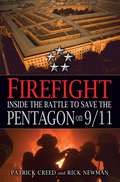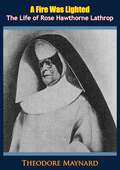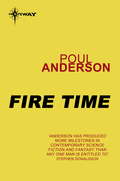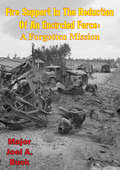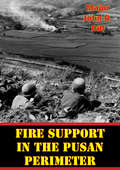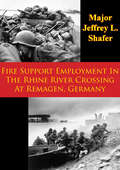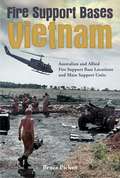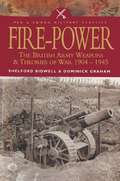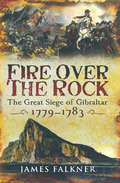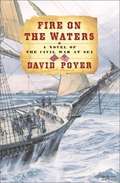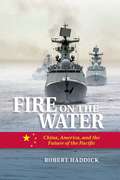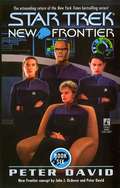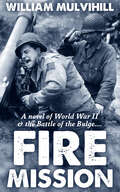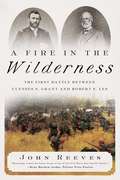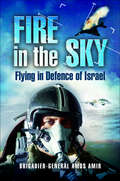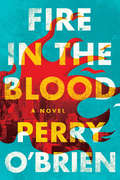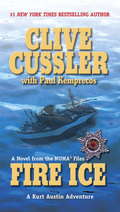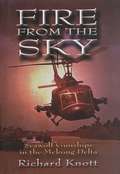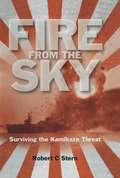- Table View
- List View
The Firefighter's Christmas Reunion: Same Time, Next Christmas The Firefighter's Christmas Reunion Fortune's Christmas Baby (Sugar Falls, Idaho #40)
by Christy JeffriesCan a chance reunion spark a Yuletide proposal?Anything can happen in Sugar Falls!Home for the holidays with her adopted son from Ghana, Hannah Gregson runs straight into her former flame—fire chief Isaac Jones. Though the pair are determined to keep their distance, the local matchmakers throw them together at every holiday event, and Hannah’s son worships the brave ex-soldier. If Isaac isn’t careful, he just may go from hero to family man by Christmas!
Firefight: Inside the Battle to Save the Pentagon on 9/11
by Patrick Creed Rick NewmanAmid all the stories of tragedy and heroism on September 11, there is one tale that has yet to be told--the gripping account of ordinary men and women braving the inferno at the Pentagon to rescue friends and co-workers, save the nation's military headquarters, and defend their country.
Firearms in Colonial America: The Impact on History and Technology 1492-1792
by M. L. BrownThis is a book about firearms. It is also a book about people and technology, for the dramatic role of the firearm as an efficient, effective tool which evolved during humankind's continuing struggle for survival cannot be minimized in any history of civilization. This book is fundamentally concerned with the Old World firearms evolution as it relates to the influence of firearms in colonial America during the period 1492 to 1792; a complex sphere of influence spanning three centuries, and intricately woven into the colorful and diverse fabric of our distinctive national heritage.
Fire Wind (Executioner, # #279)
by Don PendletonDEATH CLAUSE A black ops project has gone rogue, sending Mack Bolan into the world of shadow players and classified games as traitors in high places prepare to sell out America to terrorism and mass murder. In a mission where everyone has something to hide, Bolan goes hunting for the worst kind of savage: those sworn to protect the U.S. government. Facing off against the mercinary force recruited by the hellish high-tech conspiracy, Bolan makes his own rules. But as the boundaries of the killing game close in, he finds himself caught in a conflagration of death and corruption - and betrayed by the home team. If this mission calls for the final sacrifice, the Executioner won't be going alone.
A Fire Was Lighted: The Life of Rose Hawthorne Lathrop
by Theodore MaynardRose Hawthorne Lathrop, the daughter of Nathaniel Hawthorne, was the foundress of the Dominican Sisters of Hawthorne. Her religious name was Mother Mary Alphonsa.“Rose Hawthorne (1851-1926) was born in Lenox, Massachusetts. She was the daughter of American author Nathaniel Hawthorne (1804-1864), who was known for the probing psychological aspects of his writing derived from his Puritan upbringing. In 1871, Rose married editor George Parsons Lathrop. Sadly, their only child died at the age of five in 1881. A writer in her own right, Rose published Along the Shore, a book of poems, in 1888. In 1891, Rose, along with her husband, converted to Roman Catholicism.In 1895, Rose formally separated from George, who died in 1897. Rose then embarked on a career nursing people afflicted with cancer. In 1899, she established St. Rose’s Free Home for Incurable Cancer, in New York City. Rose became a Catholic nun and founded the Dominican Congregation of St. Rose of Lima, later changed to the Servants of Relief for Incurable Cancer. Rose’s religious name was Alphonsa. In 1901, she opened Rosary Hill Home in Hawthorne, New York, a town named after her.”-Georgetown.
Fire Time
by Poul AndersonAnu, red giant companion-star to Bel and Ea, was relentlessly approaching Ishtar - scorching the land, forcing the barbarians of the North ever southward away from the Inferno. Fire Time was fast confronting the planet; civil war broke out as the Tassui led their forces against the army of the Gathering in a desperate struggle for survival.The Gathering anxiously awaited help from the human colony in Primavera. Jill Conway and other colonists like her hoped to save the civilisation of Ishtar and they relied on the Navy of the Federation of Earth to do so. But now the Federation was engaged in its own was, an interstellar war that seemingly had no end. And no end meant no help of Ishtar...
Fire Support in the Reduction of an Encircled Force - a Forgotten Mission
by Major Joel A. BuckUsing historical analysis and survey, this study examines the sufficiency of U.S. field artillery doctrine, tactics, and techniques to support the destruction of an encircled enemy. Focus is on identifying existing weaknesses by comparing applicable lessons learned from history with the practices spelled out in current manuals. The Allied attempt to encircle and reduce the German forces within the Falaise-Argentan pocket in central France during August 1944 and the Soviet Belorussian Offensive and subsequent encirclement and reduction of German forces during June 1944 are examined. The results of a survey completed by the V and VII U.S. Corps artillery commanders on the subject are also included.Among the shortfalls identified are: current attention is more focused on breaking out of an encirclement than on forming an encirclement; when encircling an enemy is addressed, discussion stops after the encirclement is formed and before reduction begins; field artillery procedures do not separately address this mission; friendly or enemy use of chemical or nuclear weapons has not been considered; the requirement to simultaneously support reduction and exploitation operations has not been addressed; there is a need for an artillery commander at echelons above corps.The study concludes that the process of reducing a large encircled enemy force is sufficiently different from other operations that it should be separately addressed. Although the "doing" of the component parts of the artillery aspect of this operation are doctrinally established, tying them together into a synergetic package requires innovative attention. Resulting field artillery doctrine, tactics, and techniques derived are equally applicable in reducing an isolated enemy force that has broken through or been Inserted Into our rear area as they are in the reduction of an offensively encircled enemy.
Fire Support In The Pusan Perimeter
by Major John D. DillFive years after emerging victorious from World War II, the United States became embroiled in the Korean War. In August of 1950, despite the relative industrial and technological disadvantages suffered by the enemy North Korean Peoples' Army, the American Eighth Army was nearly defeated and pushed into the sea while trying to defend a toehold on the Korean peninsula around the port of Pusan. The poorly trained and equipped U.S. soldiers and marines defending the Pusan Perimeter relied heavily on fire support assets to stem the tide and defeat the North Korean attack.This monograph asks if the fire support, including both artillery and air fires, provided to the Eighth Army Infantry and Armor units was effective. It also examines the reasons for the success or failures of fire support by contrasting the use of fire support by different Army and Marine Corps units as they defended the perimeter. Additionally, the monograph addresses the question of how the force development process shaped the success or failure of the Pusan fire support effort. Finally, the monograph discusses lessons from the Pusan defense that are applicable to current fire support and force development.The monograph concludes that the fire support effort in the Pusan campaign was effective. However, because of the force reductions and training lapses that occurred after World War II in the United States Army and Air Force, it was not as effective as it could have been. The time taken to relearn the lessons of World War II and to rebuild units to doctrinal war time strength needlessly cost lives. The Pusan perimeter fight contains valuable lessons for current fire support leaders as they grapple with challenges similar to those faced by their predecessors in the summer of 1950.
Fire Support Employment In The Rhine River Crossing At Remagen, Germany
by Major Jeffrey L. ShaferThis study is an historical analysis of the procedures and doctrine used by the III Corps Artillery during the First U.S. Army's crossing of the Rhine River at Remagen, Germany. This study examines the actions of III Corps Artillery in the employment, organization for combat, and command and control of artillery units at Remagen. The fire support procedures employed by the field artillery are compared with those prescribed by published doctrine and unit standing operating procedures. This comparison is used to evaluate the adequacy of doctrine and the need for standing operating procedures to supplement the published doctrine. The development of standing operating procedures from lessons learned during earlier combat is examined to show how the doctrine allowed flexibility and standardization that was evident throughout the army. This standardization continues to serve as a model for fire support operations in today's emerging combined arms doctrine.The study concludes with lessons learned: (1) Centralized command and control of field artillery should be under the headquarters that is best organized to control a large number or units, (2) doctrine and standing operating procedures are useless unless leaders develop and execute plans that are in accordance with the principles established and practiced, (3) the tendency to establish standing operating procedures that violate or contradict doctrine should be avoided, (4) a need for more liaison officers was evident at Remagen as well as through the war and continues to exist today even with improved technology, (5) the redundancy of tasks outlined in doctrine provides the flexibility needed to accomplish the fire support mission during a fast moving battle, and (6) field artillery units should practice several tactical missions and not just the standard mission associated with peace time organizations.
Fire Support Bases Vietnam: Australian and Allied Fire Support Base Locations and Main Support Units
by Bruce PickenFire Support Bases Vietnam is a meticulous documentation of the construction, location and role of fire support bases during the Vietnam War, compiled by Vietnam veteran Bruce Picken. Often makeshift bases hacked out of primary jungle, these artillery gun areas provided essential support to infantry field units during operations in South Vietnam. In its simplest sense, a fire support base was an often hastily constructed fortified artillery base position, usually sited forward close to the centre of the area of operations in support of task force, battalion or company operations. The role of the fire support base was to bring artillery and mortar fire within range of friendly forces operating in depth. Artillery gun areas were not unique to the Vietnam conflict. In previous wars they were deployed in allied territory to cover the front lines and to support advancing troops. The concept was first applied in Vietnam by US forces and quickly adapted by Australian forces arriving in Phuoc Tuy Province in May 1966 to fight a new kind of war. This conflict was not like its predecessors and the fire support bases were now more usually sited in territory dominated by the enemy to provide much-needed protection for forces operating in bitterly contested areas. Fire Support Bases Vietnam is a detailed account that identifies every fire support base by date, location and role and provides an outline of the operations in which they participated. This is an essential reference book for those with a serious interest in the Vietnam War, and adds valuable detail to the study of a campaign that occupies a unique place in the Australian psyche.
The Fire Still Burns: a powerful story of love and peril set in pre-war Europe and Russia
by Constance HeavenLet much-loved author Constance Heaven sweep you away in this captivating and compelling romance spanning pre-war Europe. Both heart-warming and heart-wrenching, this is perfect for fans of Fiona Valpy, Kristin Hannah and Katie Flynn.'Readable and atmospheric' -- DUBLIN TIMES.'Excellent! Difficult to put down' -- ***** Reader review'Exciting read' -- ***** Reader review'A great novel from a great writer' -- ***** Reader review***************************************************************Leading a demonstration for the starving children of the Rhondda, Luke Llewellyn Jones is literally swept off his feet by the daughter of a Russian princess. For it is Tanya who first hits, then carries him in her car to her father's hospital.It it something of an eye-opener for Luke to be invited to the Cambridgeshire home of Lord Aylsham, and to meet his delightful and unconventional family who chatter as easily in Russian as English. And all too easy to fall for the lovely and impetuous girl who still insists it was him that ran into her.But Luke's dream of winning Tanya's heart is broken the moment she meets the charming but enigmatic Dirk von Richter. She leaves England to live in a Europe trembling on the brink of war.And it is in very different and dangerous circumstances that Luke risks all to see her again - among the bleak and far-flung mountains of Siberia.
FIRE POWER IN THE LAB: Automation in the Fight Against Infectious Diseases and Bioterrorism
by Scott P. Layne Tony J. Beugelsdijk C. Kumar N. PatelToday's world poses a triple threat to the American population: infectious diseases, contamination of food and water, and bioattacks (biowarfare or bioterrorism). At least 17 countries are producing weapons of mass destruction using viruses, bacteria, or their toxins. AIDS, E. coli contamination, drug-resistant tuberculosis, and virulent flu strains are perhaps the best known of a host of disease threats. What these dangers have in common is the amount of data required to achieve solutions; in some cases, as much as a petabit (1 followed by 15 zeros) of data is required to study large numbers of samples from widespread locations.Firepower in the Lab examines how the nation can combat this triple threat by improving our ability to detect, measure, and monitor harmful biological agents. It explores the potential of today's exciting new laboratory automation and computer technologies as well as the emerging tools of molecular biology--how we can generate and analyze more data quickly and reduce human hands-on involvement, which inevitably introduces errors.The book discusses how to improve and apply technologies such as robotics, laboratory automation, "lab-on-a-chip," bioinformatics, and Internet control innovations. It reviews lessons learned from our experience with pandemic flu viruses. It also presents strategies for developing new high-throughput technologies, including how to address the lack of public funding for critical research undertakings.
Fire-Power: The British Army Weapons & Theories of War 1904–1945 (Pen & Sword Military Classics #Vol. 44)
by Shelford Bidwell Dominick GrahamThe great siege of Gibraltar was the longest recorded in the annals of the British army. Between 1779 and 1783 a small British force defended the Rock against the Spanish and the French who were determined take this strategically vital point guarding the entrance to the Mediterranean. The tenacity and endurance shown by the attackers and defenders alike, and the sheer ingenuity of the siege operations mounted by both sides, make the episode an epic of military history, and the story gives us a fascinating insight into the realities of siege warfare. In this, the first full study of the siege for over 40 years, James Falkner draws on a wide range of contemporary sources to tell the exciting tale of a huge and complex operation.
Fire Over the Rock: The Great Siege of Gibraltar, 1779–1783
by James FalknerThe great siege of Gibraltar was the longest recorded in the annals of the British army. Between 1779 and 1783 a small British force defended the Rock against the Spanish and the French who were determined take this strategically vital point guarding the entrance to the Mediterranean. The tenacity and endurance shown by the attackers and defenders alike, and the sheer ingenuity of the siege operations mounted by both sides, make the episode an epic of military history, and the story gives us a fascinating insight into the realities of siege warfare. In this, the first full study of the siege for over 40 years, James Falkner draws on a wide range of contemporary sources to tell the exciting tale of a huge and complex operation.
Fire on the Waters (The Civil War at Sea #1)
by David PoyerThe year is 1861, and America shudders on the brink of disunion. Elisha Eaker, scion of a wealthy Manhattan banking family, joins the Navy against his father's wishes. He does it as much to avoid an arranged marriage to his cousin, Araminta Van Velsor, as to defend the flag. As war looms, Eli boards the sloop of war U.S.S. Owanee. There he meets Lieutenant Ker Claiborne at his own moment of decision. Claiborne, Owanee's executive officer, is an Annapolis graduate who's seen action in the West Indies and the Africa Station on the Navy's Anti-Slavery Patrol. Cool and competent in storm and battle, he now faces an agonizing choice between the Navy he loves and his native Virginia. Whichever road he takes, he'll be called a traitor. Within days, Owanee is ordered on a desperate mission to relieve Fort Sumter, the last outpost of Union authority in the newly declared Confederacy. And in Manhattan, Araminta makes her own move for independence. So begins Fire on the Waters, a tale of honor, loyalty, and the hunger for freedom. With authentic nautical and historical detail, veteran storyteller David Poyer follows Eli, Araminta, Ker, and their loved ones and shipmates into a maelstrom of divided loyalties, bitter partings, stormy seas, governmental panic, political blundering, and finally the test of battle as the bloodiest and most divisive war in American history begins.
Fire on the Water
by Robert HaddickThe main theme of Fire on the Water is that conventional measures of military balance, employed by both the general public and many policy experts, underestimate the threat that China's military modernization poses to the U.S. position in the Asia-Pacific region. Within a decade, China's leaders will have the military power to hold at risk U.S. interest in East Asia. The U.S. needs to fashion a new and competitive strategy, one that better matches the strengths of the U.S. and its allies against China's vulnerabilities, in order to maintain a balance of power in the region and convince China's leaders to pursue a cooperative course.It is not obvious to many observers why a conflict in the region is plausible, or why the U.S. should bear the responsibility for maintaining a forward military presence in the region. China has rapidly emerged as a great power and by doing so, has acquired many vital interests around the world. Following the pattern set by other such episodes in history, China is also acquiring the military means to protect its new interests, a development that puts at risk the interests of China's neighbors and the United States. The U.S. forward military presence in the region is an increasingly difficult burden to sustain. But in the long run, this approach will be less costly and less risky than encouraging China's neighbors to balance China by themselves, an alternative that will very likely result in an unstable arms race and a conflict that will damage America's interests.While it will be in America's interest to maintain its position in the Asia-Pacific region, China's military modernization is making it much more difficult for the U.S. to do so. China's military strategy, centered on its rapidly-expanding land-based and anti-ship missile forces, is exploiting weaknesses in long-standing U.S. force structure and doctrine. Due to a variety of institutional barriers, the U.S. has been slow to adapt to China's military modernization. Current efforts to respond are impractical, in that they expend U.S. resources against China's strengths rather than its vulnerabilities. The U.S. needs a new and competitive strategy that will strengthen its alliances in the region and convince China's leaders that cooperation, rather than military expansion and an attempt at regional hegemony, will be China's best course. Fire on the Water proposes reforms to U.S. diplomacy, military programs, and strategy that will offer a better chance at preserving stability. The goal of these reforms is to thwart China's well-designed military modernization plan, bolster the confidence and credibility of U.S. alliances in the region, and thus persuade China's leaders that China's best course is cooperation rather than conflict, the outcome that has usually occurred in history when a new great power has rapidly emerged.
Fire On High (Cold Equations #6)
by Peter DavidLieutenant Robin Lefler's mother died in a shuttle explosion ten years ago. So is the woman being held prisoner in Thallonian space really her? If it is, what is her connection to the mysterious woman holding a weapon that could doom entire worlds? With the lives of billions at stake, Robin Lefler, Captain Calhoun and the crew of the U.S.S. Excalibur must find the answers before time runs out for them and for the struggling remnants of the once-great Thallonian Empire.
Fire Mission
by William MulvihillFire Mission, first published in 1957, is a fictional account of a field artillery battery beginning just before the Battle of the Bulge (December 1944), to the capture of the bridge at Remagen in March, 1945. As the author served in an artillery battery during the Battle of the Bulge, his writing accurately portrays the lives of the soldiers living through the cold, filth, and death of this epic battle near the end of the war. William Mulvihill would later write the best-selling novel, The Sands of Kalahari, made into a motion picture in 1965.
A Fire in the Wilderness: The First Battle Between Ulysses S. Grant and Robert E. Lee
by John ReevesThe riveting account of the first bloody showdown between Ulysses S. Grant and Robert E. Lee—a battle that sealed the fate of the Confederacy and changed the course of American history. In the spring of 1864, President Lincoln feared that he might not be able to save the Union. The Army of the Potomac had performed poorly over the previous two years, and many Northerners were understandably critical of the war effort. Lincoln assumed he&’d lose the November election, and he firmly believed a Democratic successor would seek peace immediately, spelling an end to the Union. A Fire in the Wilderness tells the story of that perilous time when the future of the United States depended on the Union Army&’s success in a desolate forest roughly sixty-five miles from the nation&’s capital. At the outset of the Battle of the Wilderness, General Lee&’s Army of Northern Virginia remained capable of defeating the Army of the Potomac. But two days of relentless fighting in dense Virginia woods, Robert E. Lee was never again able to launch offensive operations against Grant&’s army. Lee, who faced tremendous difficulties replacing fallen soldiers, lost 11,125 men—or 17% of his entire force. On the opposing side, the Union suffered 17,666 casualties. The alarming casualties do not begin to convey the horror of this battle, one of the most gruesome in American history. The impenetrable forest and gunfire smoke made it impossible to view the enemy. Officers couldn&’t even see their own men during the fighting. The incessant gunfire caused the woods to catch fire, resulting in hundreds of men burning to death. &“It was as though Christian men had turned to fiends, and hell itself had usurped the place of the earth,&” wrote one officer. When the fighting finally subsided during the late evening of the second day, the usually stoical Grant threw himself down on his cot and cried.
Fire in the Sky: Flying in Deference of Israel
by Amos AmirGeneral Amos Amir's autobiography tells the story of the man, the warrior and the commander and the story of the struggling, newly-born, Israeli Air Force. From the Six Days War of 1967 and onward, the IAF turned to be an extremely important component of the overall Israeli defense power. The years from the Sinai War in 1956, through the Six-Day-War, the Yom Kippur War in 1973 and the Lebanon War in 1982, were the years of Amir's flying, fighting and commanding career.Amir tells his own story in talented, vivid and fluent language. He succeeds in pulling the reader into his narrow cockpit from the early stages of his flying school to later air combats and reconnaissance missions. Tense dogfights, long-range reconnaissance missions and memorable aerial episodes, including piloting a Phantom jet from the deck of the American carrier Kitty Hawk, are vividly described. The book reveals previously untold stories about the traumatic Yom Kippur War of 1973 and the early stages of the war in Lebanon in the 1982.
Fire in the Blood: A Novel
by Perry O'Brien&“A tremendously compelling debut of rare skill&” (Phil Klay, author of Redeployment) about a soldier who goes AWOL from Afghanistan and returns home to unravel the mystery of his wife&’s death. When Coop—a U.S. Army paratrooper serving in Afghanistan—is called urgently to his Captain&’s office, he fears he&’s headed for a court martial. Coop has been keeping a terrible secret from his fellow soldiers, and worries he&’s been discovered. Instead, his life is devastated in a different way: his wife, Kay, has been killed in a hit-and-run. Given a brief leave to fly back to New York and attend to Kay&’s affairs, Coop is increasingly disturbed by the suspicious circumstances of his wife&’s death. He decides to go AWOL, using his military training to uncover the real story behind Kay&’s fatal accident. As he circles in on the truth, Coop must distinguish ally from enemy among a cast of players in the Bronx underworld: Albanian heroin smugglers, shady cops, corrupt rehab doctors, and his wife&’s family, a powerful clan of financial elites. Navigating this new battlefield, he&’ll have to find justice for Kay while also seeking his own redemption. Humming with mystery and grief, Fire in the Blood is a compulsively readable thriller about the wars we fight, whether overseas, in our city streets, or in the depths of our own hearts.
Fire in My Eyes: An American Warrior's Journey from Being Blinded on the Battlefield to Gold Medal Victory
by Brad Snyder Tom Sileo<P>"I am not going to let my blindness build a brick wall around me. I'd give my eyes one hundred times again to have the chance to do what I have done, and what I can still do."-Brad Snyder speaking with First Lady Michelle Obama <P>On the night Osama bin Laden was killed, US Navy Lieutenant Brad Snyder was serving in Afghanistan as an Explosive Ordnance Disposal officer with SEAL Team Ten. When he learned of SEAL Team Six's heroics across the Pakistani border, Brad was thankful. Still, he knew that his dangerous combat deployment would continue. <P>Less than five months later, Brad was engulfed by darkness after a massive blast caused by an enemy improvised explosive device. Suddenly Brad was blind, with vivid dreams serving as painful nightly reminders of his sacrifice. <P>Exactly one year after losing his sight, Brad heard thousands cheer as he stood on a podium in London. Incredibly, Brad had just won a gold medal in swimming at the 2012 Paralympic Games. <P>Fire in My Eyes is the astonishing true story of a wounded veteran who refused to give up. Lieutenant Brad Snyder did not let blindness build a wall around him-through tenacity and courage, he tore it down.
Fire Ice (NUMA Files #3)
by Clive Cussler Paul KemprecosIn his novels Serpent and Blue Gold, #1 bestselling author Clive Cussler introduced a hero for the new millennium: Kurt Austin, the leader of NUMA's Special Assignment Team, and an instant hit with critics and fans. Tulsa World said, "As always, Cussler twists fact and fiction into a rope of tension that will leave you dangling until the last page."<P> Now Kurt Austin returns to tackle his most dangerous mission to date... In the heart of the old Soviet Union, a mining tycoon is determined to overthrow the Russian government-distracting the U. S. with a man-made natural disaster using a notoriously unstable compound known as "fire ice." Detonation of this compound could create a tidal wave big enough to destroy a major city. But Kurt Austin and his Special Assignment Team are about to make a few waves of their own....
Fire from the Sky
by Richard C. KnottThis is the dramatic history of the HAL-3 Seawolves, the U.S. Navy's first and only helicopter gunship squadron of the Vietnam War. The squadron was established "in country" to support the fast, pugnacious river patrol boats of the brown water navy. Flying combat-worn Hueys borrowed from the Army, the mission of the Seawolves quickly expanded to include rapid response air support to any friendly force in the Delta needing immediate, no-holds-barred assistance. Operating in two-plane detachments from specifically configured LSTs, hastily constructed bases, and primitive campsites, the navy gunships and their crews responded to calls within minutes. Flying in all kinds of weather, day and night, they arrived at tree-top level with forward-firing rockets and flex-guns blazing. Door gunners hung outside the violently maneuvering helicopters delivering a hail of fire with their hand-held M-60 machine guns. The Seawolves inserted SEALs deep into enemy territory, and extracted them, often despite savage enemy opposition. They rescued friendly combatants from almost certain capture or death, and evacuated the wounded when Medevac helicopters were not available.Gleaned from historical documents and the colorful recollections of more than sixty Seawolf warriors, this is the first complete history of the most decorated Navy squadron of the Vietnam War. Naval aviator Richard Knott recounts the story of the Seawolves from the dawning of the concept to the moment the last squadron commander turned out the lights.
Fire From the Sky: Surviving the Kamikaze Threat
by Robert C. StemBy late 1944 the war in the Pacific had turned decisively against the Japanese, and overwhelming Allied forces began to close in on the home islands. At this point Japan unveiled a terrifying new tactic: the suicide attack, or Kamikaze, named after the Divine Wind which had once before, in medieval times, saved Japan from invasion. Intentionally crashing bomb-laden aircraft into Allied warships, these piloted guided missiles at first seemed unstoppable, calling into question the naval strategy on which the whole war effort was based.This book looks at the origins of the campaign, at its strategic goals, the organization of the Japanese special attack forces, and the culture that made suicide not just acceptable, but honourable. Inevitably, much mythology has grown up around the subject, and the book attempts to sort the wheat from the chaff. One story that does stand up is the reported massive stock-piling of kamikaze aircraft for use against any Allied invasion of the home islands, if the atomic bombs had not forced Japans surrender.However, its principal focus is on the experience of those in the Allied fleets on the receiving end of this peculiarly alien and unnerving weapon how they learnt to endure and eventually counter a threat whose potential was over-estimated, by both sides. In this respect, it has a very modern resonance.

